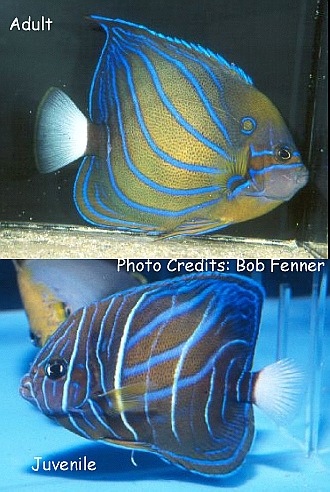
By Bob Goemans

Not Reef Tank Suitable
Likely Fish-Only Tank Suitable
Range: Indo-West Pacific: East Africa east through the Indian Ocean to Indonesia, Papua New Guinea, Solomon Islands and north to Southern Japan.
Size: 18 inches (45 cm)
Natural Environment: Inhabits coastal rocky and coral reefs mainly at depths of 3 to 200 feet (1 – 60 m) and is sometimes found in wrecks and under jetties in local harbors and bays. Adults feed primarily on sponges, tunicates, crustaceans, and zooplankton, and juveniles, who generally inhabit very shallow waters, include abundant amounts of algae in their diet.
General Husbandry: Both the juvenile and adult are quite pretty, with the juvenile having a dark brownish/bluish body with several white and pale blue bands, with the bands somewhat curved towards the tail, which is completely white. As for the adult, it has a tannish/brownish body, and has several blue horizontal curved lines that extend from the rear of the head to the dorsal and tail fin. There are also two blue stripes that cross the face, one through the eye, with the other just below the eye. Its tail is white and basically, its gets its name from a blue ring that’s located on the upper front of the body.
When first introduced into the aquarium, preferably a well-established fish-only aquarium with lots of live rock and cave areas, adults or juveniles should be offered numerous daily feedings so as to quickly acclimate it to its surroundings. Like many others in this genus, their captive diet should consist of a wide variety of frozen foods including fortified brine shrimp, mysis, and especially those containing sponge matter/angelfish food preparations and continued to be offered at least several times daily after its acclimated to its surroundings. Furthermore, flake foods, and especially those containing Spirulina and/or Nori should be also offered, along with fresh broccoli and macroalgae, as ‘greens’ make up a portion of this species diet, especially the juveniles.
Depending upon its tankmates, juveniles may be somewhat shy when first entering the aquarium, and may hide in caves and crevices. But as time passes, will become more outgoing and begin to establish its territory. As for adults, who are one of the largest in this genus, they are considered almost as feisty as those in the Holacanthus genus. And even though it all depends on aquarium size and tankmates, its safe to say it should be the last angelfish to be added to the aquarium.
FYI: Keeping more than one genus of angelfishes in the same aquarium is possible, yet depends upon several aspects. The following suggested circumstances are just that, possibilities that when heeded and adjusted to actual aquarium conditions ‘may’ make multiple angelfish collections feasible.
Aquarium size – the larger the better.
Species from the same genus should not be in the same aquarium.
The smallest and most docile genus species should be the first introduced with the largest and most malicious the last to be added.
Do not place similar coloration species in the same aquarium.
Those already in the aquarium should be well fed before adding a newcomer.
Have sufficient hiding places/rocky caves.
Do not overfeed meaty foods, especially juveniles, as it may lead to a fatty deposit around the liver that could stop production of vitamin A. This could cause blindness, often referred to as nutritional blindness.
Keep in mind all angels have cheekspines at the edge of their gill cover; therefore use caution when handling and also avoid using a net to capture it, as it may become stuck or tangled in the net and become damaged when removed.
Experience Level: Intermediate
Temperament: Semi-aggressive
Diet: Omnivore
Acclimation Time: 30 minutes+
Aquarium Environment: Fish-only and Reef Aquariums (See Below)
Reef Safe: Juveniles – Yes/Adults - No - will nip clam mantles, large and small polyped stony (LPS/SPS) corals, and also some soft corals and tubeworms.
Minimum Tank Size: 180 gallons
Temperature Range: 72 - 81°F (22 – 27°C)
Specific Gravity: 1.020 - 1.026
pH: 8.0 - 8.5
